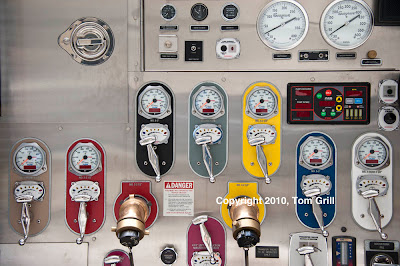I am frequently asked to suggest a camera pros can carry around as a point-and-shoot that can deliver acceptable quality for submitting to traditional stock agencies. Until recently, such a camera did not exist. They were too bulky to qualify as pocket portable, or the quality was really point-and-shoot and totally unacceptable. Many of my pro friends tried the Canon G11 because it looked the part of a professional camera, Unfortunately, this camera really is just a glorified point-and-shoot on the inside with a minuscule-sized sensor -- the same one Canon has in its S90. Most of my friends passed their G11’s on to their wives or kids.
Recently, a new crop of small cameras have hit the market. Olympus and Panasonic introduced their Micro Four Thirds series with sensors that are about half the size of a 35mm full frame. Leica just came out with the X1. It has an APS-C sized that is the same size as found in many pro-level cameras, and is two thirds the size of full frame 35mm. In digital photography sensor size may not be everything, but it is definitely one of the most determining factors in image quality.
I performed extensive tests with this new crop of cameras and this blog entry is the result.
Leica X1 – following in a great tradition
The X1 and an original Leica 1 of 1930.
The first thing that surprised me when I picked up the X1 is how small and light weight it is. It has one fixed lens, a Leitz 24mm f/2.8 Elmarit Aspherical. This is equivalent to about a 36mm lens on a 35mm full frame camera. The sensor is a 12.2MP CMOS (23.6mm x 15.8mm), similar to that found in pro level cameras like the Nikon D300s. The display is 2.7” and easy to see in sunlight, although most pros would probably prefer to use the auxiliary viewfinder available for this camera.
With the battery in it the X1 weighs in at 11.8 oz., which is truly point-and-shoot size. It was the lightest camera of all those I tested and lighter even than the G11.
Leica X1 with 24mm Elmarit lens
The X1 uses one SD/SDHC card and was indicating 94 images in RAW (DNG) plus fine JPG on a 2GB card. The battery is capable of 260 exposures on a 200 minute charge. The flash is a pop-up with a range of 7’ at ISO 100, however the hot shoe is compatible with the Leica SF24D and SF58 flashes.
ISO
The ISO range is rated at 100-3200, and this is one of the few cameras I have found able to justify this claim. I was stunned at the high image quality produced at ISO 3200. Not only was the noise level low, it had a quality reminiscent of film grain – really beautiful. Like to shoot at high ISO ranges? Not a problem, this is the camera to use.
Controls
Simplicity of use is the name of the game here. There are two dials on top of the camera. One controls shutter speed, the other handles lens openings. Put them both on “A” and the camera is essentially in “Program” mode. Change the shutter speed dial while the lens opening dial is on “A” and you are in shutter priority mode. Change the lens opening dial while the shutter speed dial in on “A” and you are in aperture priority mode. Change both dials and you are in manual mode. Absolute simplicity. I don’t know why no one ever thought of this before.
The motor drive is 3fps in jpg and 2fps in DNG with a burst of 6 images.
Image Quality
The quality is what you might expect from a high grade digital camera from Leica – in a word: “Excellent”. The images from this camera already fit the standards for commercial stock photography. You don’t have to massage them. They meet the highest criteria right out of the camera with no special post-processing necessary. Take a look at the detail in the Hi Res versions of the sample images below. It really is on a par with what you would expect from a professional camera.
Conclusion
About the only thing this camera has in common with a point-and-shoot is size and weight. In all other respects this is a professional grade digital camera capable of delivering image quality on a level with the best DSLR cameras out there.
The only drawback of the X1 may be that it has only one fixed lens. On the plus side, that lens is a superb Leitz Elmarit with no distortion. On larger sensors it is difficult to keep lens size within bounds of a point-and-shoot size – and there is the trade off. If you want to add a zoom lens to a large sensor camera, you wind up with something that no longer fits in your pocket.
At $1995 it is an expensive camera, but image quality of this type doesn’t come cheap. It is the only camera available at this quality level that actually does fit in your pocket. With all three test cameras available to me I found it was the X1 that I grabbed when I was going out for a walk.
The Leica X1 delivers professional stock images right out of the box, even in low light situations
Panasonic DMC-GF1 and Olympus E-P1
I tested these cameras together because their development was in tandem and they come from a similar mold. Together, Panasonic and Olympus developed the Micro Four Thirds format, and have the same, interchangeable lens system. Sensor size is about half of a 35mm frame, which, as digital sensors go, should be large enough to produce professional quality images. Both cameras come in at a little above 12MP.
The only way these cameras can truly fall into a point-and-shoot category is if you only use the pancake lenses available. That would be the 17mm f.2.8 on the Olympus, and the 20mm f/1.7 lens on the Panasonic GF1. Once you add any other lens, the cameras bulk up to a point where they will no longer fit in a pocket.
On the other hand, the extensive lens assortment available for these cameras make them attractive as small systems. I did test a number of the regular zooms made for these cameras. I found the resolution of these lenses to be a bit on the softer side when compared to a professional quality DLSR lens. Nonetheless, they are acceptable as you can see by downloading the Hi Res images above.
ISO range
The rated ISO range of the Panasonic GF1 is 100-3200, and 100-6400 on the Olympus E-P1. As far my tests go, these are very optimistic claims. I think the GF1 can produce usable images up to ISO 1000, while the E-P1 could go to a maximum of 1600. Beyond that and the images are too noisy to be acceptable by commercial stock photography standards and are beyond the range for acceptable correction by noise lowering software.
Download Hi Res ISO test images of the Olympus E-P1:
Download Hi Res ISO test images of the Panasonic GF1:
Controls and features
The controls and menus of these cameras are full of options and pre-packaged shooting modes, all of which leads to complexity in handling. Expect to carry around the user manual with each of them.
Situations with people are difficult to focus accurately with this type camera because you cannot put a pinpoint focus spot on the subject's eyes. (E-P1 42mm lens) Download Hi Res image here.
Both cameras shoot at a respectable rate of 3fps, and both have a generous 3” LCD screen for viewing in live mode. They also both shoot video, but that is beyond the scope of this review.
Image Quality
The images from these cameras would be acceptable in terms of commercial stock standards with a few caveat. ISO noise levels are excessive and need to be carefully treated anywhere above ISO 800. Images are generally not as sharp as you would achieve with a pro lever DSLR. They are a tad soft – mostly acceptable, but definitely a bit soft when using the manufacturers lenses. Keep in mind that with adapters you could use other lenses, even Leica lenses on the Micro Four Thirds cameras, but that is not a convenient option when all things are considered.
Accessories
A separate SLR-type viewfinder is available for both cameras, however this does increase the camera size considerably. The Olympus does not have a built-in flash so it will need the optional flash – yet another thing to bulk up the overall camera kit.
The list of available lenses for these cameras continues to grow, and may be one of their more attractive features. Adapters are also available for using other manufacturers lenses on these cameras. In this case auto-focus and auto-exposure may no longer be available.
Conclusion
Initially, I had expected that the Micro Four Thirds format would be the perfect solution to a convenient camera to have with me at all times for those spur of the moment shots. After testing the cameras, however, my enthusiasm waned. I found the cameras too bulky once zoom lenses and accessory viewfinders were added. More importantly, the image quality was disappointing. It required careful post-processing to deliver acceptable stock photos.
Bottom line is that these Micro Four Thirds cameras in the hands of a professional photographer are capable of delivering the goods. My recommendation would be to keep ISO levels on the low side (below 800) whenever possible. I would also refrain from cropping too much because the images are just not as sharp enough to handle it. While not as good as a pro level DSLR, these cameras are capable of producing acceptable images for traditional commercial stock photography.
While you are probably not going to stick one of these cameras in your pocket, you can put together a small, convenient kit to carry around in a bag for shooting travel images on the go.
























































